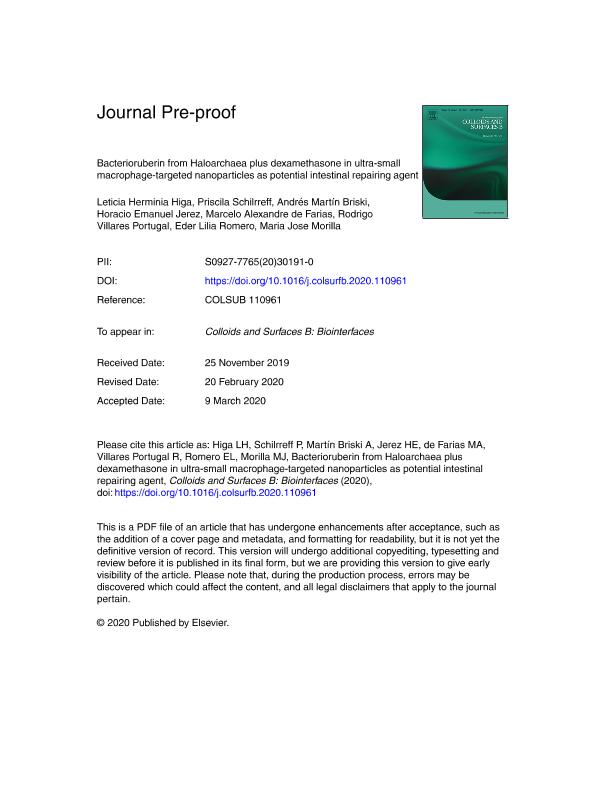Artículo
Bacterioruberin from Haloarchaea plus dexamethasone in ultra-small macrophage-targeted nanoparticles as potential intestinal repairing agent
Higa, Leticia Herminia ; Schilrreff, Priscila
; Schilrreff, Priscila ; Briski, Andrés Martín; Jerez, Horacio Emanuel
; Briski, Andrés Martín; Jerez, Horacio Emanuel ; de Farias, Marcelo Alexandre; Villares Portugal, Rodrigo; Romero, Eder Lilia
; de Farias, Marcelo Alexandre; Villares Portugal, Rodrigo; Romero, Eder Lilia ; Morilla, María José
; Morilla, María José
 ; Schilrreff, Priscila
; Schilrreff, Priscila ; Briski, Andrés Martín; Jerez, Horacio Emanuel
; Briski, Andrés Martín; Jerez, Horacio Emanuel ; de Farias, Marcelo Alexandre; Villares Portugal, Rodrigo; Romero, Eder Lilia
; de Farias, Marcelo Alexandre; Villares Portugal, Rodrigo; Romero, Eder Lilia ; Morilla, María José
; Morilla, María José
Fecha de publicación:
07/2020
Editorial:
Elsevier Science
Revista:
Colloids and Surfaces B: Biointerfaces
ISSN:
0927-7765
Idioma:
Inglés
Tipo de recurso:
Artículo publicado
Clasificación temática:
Resumen
Oral administration of antioxidant and anti-inflammatory drugs have the potential to improve the current therapy of inflammatory bowel disease. Success of oral treatments, however, depends on the capacity of drugs to remain structurally stable along the gastrointestinal tract, and on the feasibility of accessing the target cells. Delivering anti-inflammatory and antioxidant drugs to macrophages using targeted nanoparticles, could make treatments more efficient. In this work structural features and in vitro activity of macrophage-targeted nanostructured archaeolipid carriers (NAC) containing the high antioxidant dipolar C50 carotenoid bacterioruberin (BR) plus dexamethasone (Dex): NAC-Dex, are described. Ultra-small (66 nm), -32 mV potential, 1200 g Dex /ml NAC-Dex, consisted of a compritol and BR core, covered by a shell of sn 2,3 ether linked archaeolipids and Tween 80 (2: 2: 1.2: 3 % w/w) were obtained. NAC-Dex were extensively captured by macrophages and Caco-2 cells and displayed high anti-inflammatory and antioxidant activities on a gut inflammation model made of Caco-2 cells and lipopolysaccharide stimulated THP-1 derived macrophages reducing 65 % and 55 % TNF- and IL-8 release, respectively and 60 % reactive oxygen species production. NAC-Dex also reversed the morphological changes induced by inflammation and increased the transepithelial electrical resistance, partly reconstituting the barrier function. Activity of BR and Dex in NAC-Dex was partially protected after simulated gastrointestinal digestion, improving the chances of BR-Dex joint activity. Results suggest that oral NAC-Dex deserve further exploration as intestinal barrier repairing agent.
Palabras clave:
ORAL DELIVERY
,
INFLAMMATORY BOWEL DISEASES
,
CACO-2/THP-1 CO-CULTURE
Archivos asociados
Licencia
Identificadores
Colecciones
Articulos(SEDE CENTRAL)
Articulos de SEDE CENTRAL
Articulos de SEDE CENTRAL
Citación
Higa, Leticia Herminia; Schilrreff, Priscila; Briski, Andrés Martín; Jerez, Horacio Emanuel; de Farias, Marcelo Alexandre; et al.; Bacterioruberin from Haloarchaea plus dexamethasone in ultra-small macrophage-targeted nanoparticles as potential intestinal repairing agent; Elsevier Science; Colloids and Surfaces B: Biointerfaces; 191; 7-2020; 1-18
Compartir
Altmétricas



